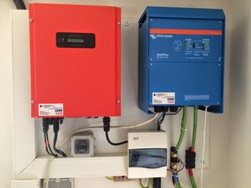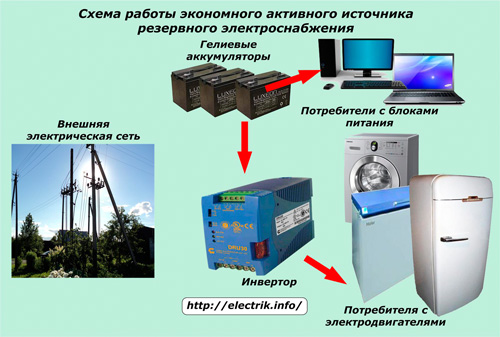Categories: Featured Articles » Autonomous power supply
Number of views: 19536
Comments on the article: 2
Backup power system for the home - features of the device and operation
 Technological progress does not stand still. Residents of multi-storey buildings in megacities are beginning to forget cases of prolonged blackouts and all the troubles associated with them. However, for the rest of the population this issue has not yet been completely resolved.
Technological progress does not stand still. Residents of multi-storey buildings in megacities are beginning to forget cases of prolonged blackouts and all the troubles associated with them. However, for the rest of the population this issue has not yet been completely resolved.
Backup power issues for owners of a detached private house or cottage are still relevant. Our state is not yet able to fully provide high-quality electricity.
How is the backup power system for the home
The composition of the classic complex of technical backup devices
To ensure the normal operation of household electrical appliances in the event of loss of external electrical energy, use:
-
a set of batteries that create a total voltage of 12, 24, 36 or 48 volts;
-
an inverter that converts the direct current of the battery into alternating 220V.
Modern systems do not just deal with redundancy, the function of which in the recent past was quite often performed by manual switching of the operator, but they provide uninterrupted power supply in automatic mode without human intervention.
Uninterruptible Power Supplies (UPS)operating under the “Off-Line, Standby” backup scheme under normal load conditions perform 2 functions:
1. monitor the state of the primary electrical network by filtering power surges and electromagnetic interference in it;
2. charge the battery to maintain its rated capacity.
When the parameters of the external supply network go beyond critical values or the power is completely turned off, the UPS automation reconnects the load on the inverter, which takes the direct current from the batteries.

A controller-based automation system is often integrated into the design of a modern inverter. The above picture shows the conditional division of electricity consumers into two groups with asynchronous electric motors and electronics power supplies. Usually they are plugged in at the location in the apartment.
This backup source circuit is usually called active because it constantly monitors the network parameters, connecting the autonomous power supply to the load after it has determined that a malfunction has occurred in the power supply circuit. With this method, automation requires at least a small, but quite definite time to analyze the situation and perform switching. At these moments, a short dead time pause is formed.
Its mandatory presence is the main disadvantage of this system, but, in practice, it does not have a special effect on the operation of household appliances. After all, rotating electric motors continue to work by inertia, not having time to stop, and the electronic circuits of microprocessor-based computer devices are connected to the backup power supply of the UPS using exactly the same algorithms.
How to reduce the load on the inverter and battery
When switching, you can reduce the energy losses that occur in the circuit and extend the battery life in several ways.
Lighting lamps
The organization of the backup power system and its cost are closely related to the power consumption of the network. Therefore, the issue of saving electricity and the transition to energy-saving technologies should pay special attention.
To reduce the load on the inverter, and at the same time the size of the lighting charge, you can simply replace ordinary incandescent lamps with fluorescent, halogen, energy-saving (compact fluorescent) or LED lights.
You can also divide the sources of electric light into two groups:
1. permanent use;
2. duty local lighting.
When switching to work from the inverter, this will only allow limited sources to be used, and all the rest should be connected exclusively as necessary.
Simplification of algorithms for household appliances
Almost all electronic devices (televisions, computers, telephones and other devices) have power supplies that create 12 volts of direct voltage from a variable network 220. They can be made built-in designs or remote, like a laptop.

When such receivers of electrical energy are powered from the inverter, and not from an external network, then with a conventional connection scheme, a double conversion of energy occurs:
-
first, the inverter takes a voltage of 12 volts from helium batteries and converts it to ≈220, which is fed to the laptop, as in our case;
-
then the power supply unit of these devices ≈ 220 V rectifies again at ± 12 V.
It is quite logical to exclude such processes from the algorithms and, when switching to backup power, use a circuit when the inverter controller directly supplies 12 volt battery voltage to all electronic components of the computer without wasting energy on its double conversion. This can be accomplished by creating a circuit of parallel outlets for connecting helium batteries to such devices.

However, the above example with a laptop is shown only to demonstrate the principle of constructing a backup power scheme, although the mobile computer itself has a built-in battery that performs the functions of a UPS.
When external power is disconnected in a similar circuit, the load on the inverter and the battery as a whole is reduced.
Reservation of energy of the sun, wind, water, internal combustion engine
With correctly selected circuit, helium batteries can reserve power for a long time, but their capacity is not infinite. The time will come when they will require recharging.
For this, the energy of other current sources is usually used:
-
solar battery;
-
electromagnetic field of a working generator.

The use of solar energy
Designs of solar cells are constantly being improved, are popular. They can increasingly be found not only in the reservation systems of household consumers, but also as the main sources of electricity.
When using solar panels, it is important to adjust the controller operation algorithm so that solar energy not only supports the capacity of helium batteries, but also directly flows to consumer power supplies with an electronic circuit, supplying them with electric current.
Read more about the use of solar panels in the backup power supply system here: Solar power plants for the home
Using generator sets
For domestic use, rotary AC machines. They have generators according to the ratio of rotating electromagnetic fields of the rotor and stator:
1. synchronous;
2. asynchronous.
The first designs are more complex, they well perceive inductive loads created by rotating electric motors, but more expensive.
Asynchronous generators are mainly designed to supply active loads from incandescent lamps in lighting circuits, thermal electric heaters (TEN) and similar devices. To supply reactive consumers with them, it is necessary to provide a significant margin of generator power because they poorly tolerate the asymmetric components of transients that occur in the circuit when starting electric motors.
To promote and maintain rotation of the generator rotor, it is necessary to apply a torque to it. Its source may be energy:
-
wind;
-
water currents;
-
internal combustion engine.
Wind energy for the home
It belongs to the environmentally friendly technology for generating electricity.However, a backup power system for the home, based on the capture of wind energy, may not always be effective. Volumes and speeds of air masses moving in the atmosphere in different climatic conditions differ significantly.
In most of Russia, winds are not permanent, depending on many reasons, including the time of year and weather conditions. They are monitored and collected by the meteorological service. From their measurements, you can only approximately evaluate the efficiency of using wind turbines to generate and transmit torque to a generator.
The power generated by the wind generator is also affected by:
-
wind turbine design;
-
the choice of location and height of the impeller;
-
correct installation;
-
applied circuitry and many other factors.
Read more about using wind power here: Wind generators in Russia - how to choose, install and avoid disappointment
Harnessing the energy of moving water
The use of hydropower in the home can greatly facilitate the life of the owner of the house. But, rivers and streams do not always flow near our homes ...
In addition, our ponds usually freeze in winter, covered with a layer of thick ice. And this greatly complicates the power supply, but does not completely exclude its use.
Modern techniques for installing hydraulic turbines below the ice formation depth allow energy to be taken from moving water flows year-round.
For sampling the power of the hydraulic flow at home, simple damless hydroelectric structures are best suited. They can be performed based on:
-
water wheel;
-
propeller;
-
rotor Daria;
-
garland hydroelectric power station.
The use of thermal energy of fuel in an internal combustion engine
Modern ICE for home generators work on:
-
gasoline;
-
diesel fuel;
-
natural or liquefied gas.

Gas generators usually designed to generate electricity of relatively small capacity for several hours. They are created with a water or even air cooling system, equipped with asynchronous generators.
Gasoline engine designs do not take up much space, are compact, convenient for transportation. They are often used to power cottages, conduct short construction works where there is no stationary electric network.
But for long-term power supply of powerful consumers in extreme operating conditions, they are not suitable.
Diesel generators for domestic use are created more powerful. Depending on the design of the engine cooling system, they can be designed for continuous operation.
Manufacturers produce them with synchronous or asynchronous generators, supply control systems and automation of varying complexity. Popular are the designs of modular container devices of DES.
The presence of the ABP function expands the capabilities of diesel power plants in backup power systems for the home.
However, they, like gasoline engines, emit toxic combustion products into the atmosphere, create a lot of noise, vibration. This requires the adoption of special technical measures to reduce these harmful factors.
Gas generating power plants run on natural or liquefied gas. They are connected to a stationary gas network or liquefied gas storage tanks. The cost of their operation is lower than that of gasoline and diesel stations due to the lower price for gas.
They can include asynchronous or synchronous generators, automation systems of varying complexity. Most often they are made in a container version for long uninterrupted operation in automatic mode with the possibility of remote control and control.
In addition, emissions of combustion products into the atmosphere from these engines are characterized by a low content of harmful substances.
A wide selection of power sources of various capacities and designs, using energy carriers available for a given area, allows the owner of the house to choose the most suitable backup power system for his needs.
Read also on this topic: How are uninterruptible power supplies (UPS) arranged and working?
See also at bgv.electricianexp.com
:
